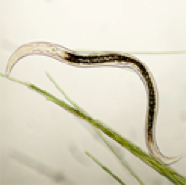Reluctant swimmers
Microorganisms routinely live in complex fluids such as mud, intestinal fluid, and mucus. In this world of varying rheological properties, organisms propagate with a motion analogous to swimming. Think of spermatozoa propelled by undulations of flagella. Researchers have known that the properties of a fluid strongly affect how the organisms swim in it—the beat of a spermatozoon’s flagella, for example, goes from sinusoidal in an “ordinary” Newtonian fluid to asymmetric in a viscoelastic fluid, a medium that shows both solid- and fluid-like behavior—but quantitative studies have been scarce.
In a paper in Physical Review Letters, Xiaoning Shen and Paulo E. Arratia, at the Department of Mechanical Engineering and Applied Mechanics, University of Pennsylvania, report usage of video microscopy and velocimetry methods to measure body kinematics and swimming dynamics of a species of roundworm in a range of shear viscosities and viscoelasticities. They find that the fluid elasticity hinders swimming speed as well as efficiency. This result is surprising, if only because myriad biological processes occur in such fluids. Examples range from sperms in the female reproductive tract to allergens in the respiratory passage. The authors find that the roundworm’s swimming speed is reduced by up to compared to that in ordinary fluids. This work provides a valuable experimental benchmark for what appears to be a ubiquitous phenomenon. – Sami Mitra





